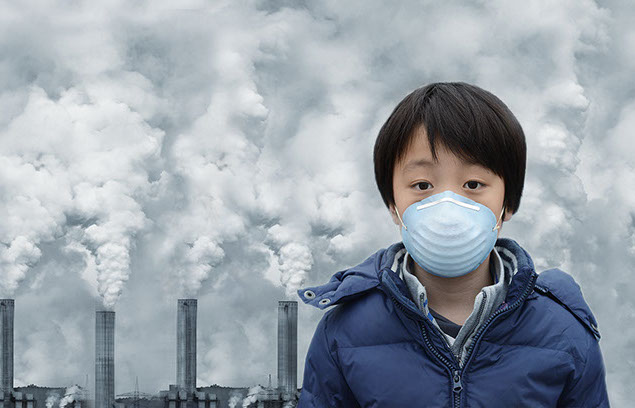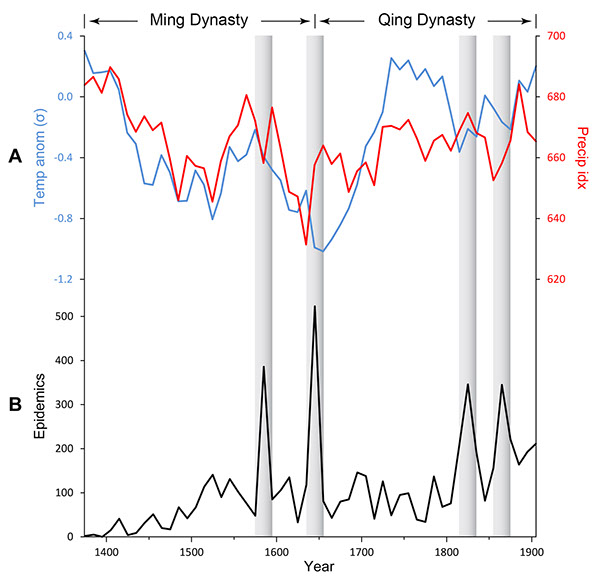
Epidemics And
Climate Change
Data from China shows how epidemics, alongside other human catastrophes, can be triggered by climate change.
Scholars in the Department of Geography have been using a rich trove of data from historical documents to show the human impact of climate change. Their first efforts, published a few years ago, found climate change was linked to human crises across the northern hemisphere between 1400 and 1900, in particular wars in both China and Europe. Now, the focus is on an outcome that is especially pertinent to the 21st century: epidemics.
In these days of bird flu and SARS, the scourge of epidemics is once again threatening the population. Dr Harry F Lee, who worked with Professor David D Zhang on the war study, has found evidence that past epidemics coincided with climate change.
“When we talk about climate change in the past, we mean cooling. It’s only from the 20th century on that we talk of warming. But whether the temperature is too high or too low, the issue is whether it is the optimum. Cooling was disastrous for the middle to high latitude regions in the world,” he said.
The reason was the impact on grain production, which was the most valuable resource of the day. Sharp drops in production brought on by colder-than-average temperatures gave rise to conflicts and also epidemics.
Dr Lee showed the impact on human health by using county-level data from China on epidemics and comparing that with the temperature records. Some 5,961 epidemics incidents were recorded between 1370 and 1909 and the outbreaks peaked around the time that temperatures, and per-capita grain production, were at their lowest.
Individuals with lower nutritional intake have weaker resistance to disease. They are also more likely to move in search of more resources, thus helping disease spread.
Dr Lee said it was important to understand that the impact depended on population size as well as fluctuations in climate. After a long period of stable temperatures, the population size would grow, meaning more grain had to be produced. When temperatures dropped, the pressure on grain resources would start to be felt, but it would take many years of falling temperatures for the situation to get catastrophic, he said.
“We’re talking about whether a society can cope with a long-term phenomenon. If the temperatures are cooler for one or two years, people can cope. But based on the data from the past, when the phenomenon is long-term, people do not have sufficient capability to cope with it,” he said.

![]() If the temperatures are cooler for one or two years, people can cope. But based on the data from the past, when the phenomenon is long-term, people do not have sufficient capability to cope with it.
If the temperatures are cooler for one or two years, people can cope. But based on the data from the past, when the phenomenon is long-term, people do not have sufficient capability to cope with it. ![]()
Dr Harry F Lee
Iraq invasion inspiration
His inspiration for pursuing this line of research was a modern war over resources – the US invasion of Iraq in 2003, which can be seen as a conflict to gain control over oil fields. “Oil is a very important resource of the present day and so we thought: What was the most important resource of the past? The definition of resources will change over time. Oil was not important in the past but food production was,” he said.
Yet food remains an unstable but valuable resource in poorer areas of the world. The patterns
revealed in his data could repeat in these regions as climate change – this time warming – takes effect, he said. Indeed, other researchers have linked social stability in Sub-Saharan Africa to climate change.
Dr Lee next hopes to address the constraint of studying climate change on a range of temporal and spatial scales, to see if it is possible to understand, for example, the effect it has on a place as small as Hong Kong. It is a challenging task given the need for high quality data, but the outcome could be important in convincing people of the impact.
“When you look at places as large as Asia or Europe, you have no problem seeing the influence of climate change. But if you talk about Hong Kong or the New Territories, it can be difficult to detect the impact. I’m trying to see whether there is a threshold,” he said.
Next
Climate change and epidemics in the whole of China, 1370–1909 CE. (A) Temperature anomaly (blue line) and precipitation index (red line), and (B) count of epidemics incidents. The aberrant peaks of epidemics
(in 1580s CE, 1640s, 1820s, and 1860s) coincide with the fall in temperature. Additionally, the last three spikes of epidemics are also matched with the Manchurian Invasion, Hakka Migration, and Taiping Rebellion – the historical events associated with mass migration.



